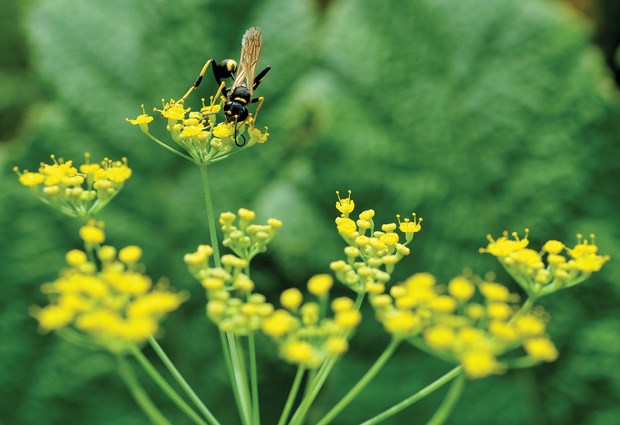It's mid August, the sun is shinning and the garden is ablaze with colour and fragrance.
It's a glorious time to be in the garden during summer's long days. This is a great time of year to take stock of how design changes have worked out. Look carefully at plant heights and bloom times to see if your design has achieved the desired affect. Make notes for those plants that may need transplanting or division in fall.
Even though we are enjoying lovely summer weather there's still work to do beyond design changes. I have put together some simple pest management strategies for the summer garden.
Love your bugs! Yep, that's right, you gotta love your bugs. Insects of all types play important roles in our environment. And even though a few insects may become problematic, in large part bugs are good for the garden. It's important to avoid all pesticides and herbicides because nature's smallest creatures are extremely sensitive.
If you are growing using an organically holistic method to control insect pests, now is the time to check on predator and prey balance. With aphids for example, look carefully using a magnifying glass to inspect how many aphids are dead, parasitized or being eaten. Predatory wasps, ladybugs and lacewings (adult and larvae) will be noticeable if the garden's ecology is healthy. Parasitized aphids will look pale brown, tan or black and stuck in place on the plant stem. The larval or juvenile stages of lacewings and ladybugs will be visible actively eating within aphid colonies. Check online to learn what the larval stages of those insects look like.
Other helpful things to do for your bugs include: Catch flying insects, like mosquitoes, by leaving spiders and their webs alone because they're working every day catching insects and keeping things in balance. Watch out for those little jumping spiders which are good at catching many pests that crawl on the ground. Leave pill bugs or sow bugs to do their work. Those insects are important decomposers in the food chain. Sow bugs eat dead and decaying plant mater and turn it into food for plants. It's like having your own little army working tirelessly producing free compost. Many of the insects that decompose organic matter are often mistaken for pests, making proper identification of any insect crucial to good management.
Since the garden is more than a collection of disparate elements, when it comes to managing pests, it is important to enhance the various functional parts of the garden to improve plant health. Soil health, for example, is often overlooked as a contributing factor in pest problems. However, poor soil health is a primary reason for increased disease and insect attack. Soil improvement is a whole other discussion, but soil maintenance starts with proper mulching.
Keep your planting beds mulched to provide a home for all those good bugs. A good thick layer of shredded wood chips is my top choice for mulch. My second favourite mulch material is bark mulch, preferably all Douglas fir, but the standard hemlockfir mix is also excellent. I know many people do not like bark mulch but it has no negative affect in the garden. There is no other product that is locally produced, sustainable, environmentally friendly and affordable. Contrary to the many myths about bark - including bark brings ants and attracts sow bugs - bark mulch actually supplies excellent nutritional, cost and weed suppression benefits in the garden. Do not dig mulch into the soil unless it has been sufficiently composted.
Promoting the health of predatory insects is another way to keep insect pests under control.
Start by thinking about the most basic things all living creatures need to survive - food and water. Besides eating insect pests, predatory insects eat pollen and nectar from a wide range of trees, shrubs and perennials. The key here is to provide a diversity of flowering plants.
Good design is not only beautiful it also benefits the garden's ecology. I like bronze fennel (Foeniculum vulgare Purpureum) for its picturesque blooms in mid-summer that provide abundant pollen and nectar for beneficial insects. The tiny yellow flowers are flattened, compound umbels which are ideally suited to the mouthparts of many predatory wasps.
I can count as many as nine different species of hymenoptera and chalcid wasps feeding on fennel during summer. Many of those species are aggressive predators of several insect pests found in gardens.
By planting a diversity of flower types and bloom times, you can supply beneficial insects with food to keep them going in between meals of pests.
Water is also a key element of life so provide a bird bath, mist plant foliage in the evening and water the high trunks of trees to provide water for thirsty bugs.
Todd Major is a journeyman horticulturist, garden designer and builder, teacher and organic advocate. For advice contact him at [email protected]



